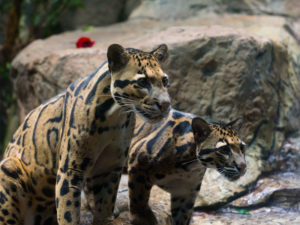Neofelis nebulosa
Fast Facts
- Clouded leopards have the largest canine teeth in relation to their body size of any of the big cats.
- The Clouded leopard has a very long tail, taking up almost half the length of its body. Only the Marbled cat, which lives in the same region as the Clouded leopard, has a longer tail-to-body ratio of any cat.
- Although not truly prehensile, Clouded Leopards can use their tails to help counter balance onto branches. Their long tails are mainly used for balance, especially while climbing.
- Their whiskers can detect movement within five nanometers, which is 2,000 times less than the width of a human hair.
- They can also hang upside down from trees with their back paws.


Range
Himalayan foothills, Southeast Asia, and China

Habitat
Lowland tropical rainforests, dry woodlands, and secondary forests

Size
20 to 22-inches tall at the shoulder, and 4-6 feet long

Nutrition
Deer, birds, monkeys, porcupines, pigs, and goats
Characteristics
These cats gained their name from the cloud-like pattern on their fur, which helps them blend in with their habitat. These ‘cloud’ spots are edged in black and the inside of each spot is darker than the background fur color. The background fur ranges from ochre, to tawny, or silver-gray in color. Solid black spots mark their head and ears, while broken lines and stripes run over their cheeks and across their nape. The blotches elongate along the spine, and the forelegs and flanks are marked with irregular spots and oblique, curved, or looped stripes. The underparts, tail, and legs are spotted.
Behavior
Clouded leopards have keen sight, hearing, and smell and are most active at night. Captive leopards mark their territory in a variety of ways, including head-rubbing, scraping, clawing trees, and urine spraying. They make a variety of growling, moaning, hissing, spitting, and snorting vocalizations, including a snort called ‘prusten’ (also called chuffing) for friendly interaction. They use their sensitive whiskers for body language, protecting their eyes, hunting, and nocturnal navigation. Clouded leopards hunt using a stealthy approach and pounce. They are equipped with enlarged canines capable of killing prey with a single bite to the throat or skull.
Reproduction
Very little is known about Clouded leopard reproduction in the wild. Nearly all research comes from observation of captive animals. The compatibility of each individual male and female is crucial to successful reproduction, and the pairs are often matched at a young age to aid in the process. Male aggression can occur during breeding, resulting at times in the death of the female due to the bite on the back of the neck used during copulation. These cats reach sexual maturity at 20-40 months old, and the males do not participate in the rearing of the young.

